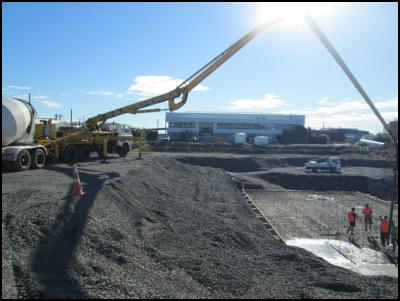A Good Start For Napier’s Wastewater Treatment Upgrade
A Good Start For Napier’s Wastewater Treatment
Upgrade
Ground improvements are nearly completed on the Awatoto site where Napier’s waste water treatment is undergoing a $30m upgrade.
The Waitangi Road site is being prepared for the construction of a biological trickling filter (BTF) plant. This is one of the biggest projects ever undertaken by the Napier City Council.
The base slab for the main effluent pump station has been poured below ground level. Passersby may have noticed small mountains of shingle formed to compress the site, including the area where the new BTF tanks will operate. This compaction process is further improving ground stability.
Council staff are working on tender documentation for the manufacture of plastic media and distributor arms for the BTF tanks – equipment that will be produced offshore.
A tender is expected to be awarded February to assemble the media into blocks for placing in the two tanks – a process expected to take several months.
Construction work building the BTF tanks and other site structures will get underway in mid-2013.
Caption: A massive boom pours concrete for the new pump station’s base slab. In the background is the existing milliscreening plant.
Backgrounder
Tandem
Treatment for
Wastewater
The existing
milliscreen plant has been treating the city’s wastewater
since 1991. The BTF plant will provide a secondary
treatment process to follow milliscreening and a new grit
removal process.
BTF is a fixed-film biological treatment process that is very well established, both in New Zealand and overseas. Compared to many other treatment processes, it is relatively economical and simple to operate. Wastewater flows through tanks with plastic filter media on which an active bacterial mass establishes to feed on and transform human waste into a non-offensive bacterial biomass.
The BTF plant will incorporate structured media, which is used in the Gisborne BTF plant and has also been trialled in the pilot plant at Napier. The two tanks containing the media will be covered to control odour, with air treated in a biofilter field of chipped bark.
The system’s only moving part is a sprinkler arm for distributing the wastewater. Other major advantages of the BTF process are that there will be no sludge transportation or disposal costs and it avoids the use of chemicals, which would eventually become part of the discharge.
As the final stage in the process, the treated wastewater will flow through a Papatuanuku channel (an open channel filled with rocks) as a spiritual cleansing before discharge via a 1.5km outfall into Hawke Bay, south of the city at Awatoto. Scientific studies show that the receiving environment is well able to accept such a discharge.
A pilot plant has already been successfully trialled on the Awatoto site under local climatic conditions and using Napier sewage.
The design will allow for other treatment stages to be added in the future if needed.
Preparatory work undertaken at the milliscreen plant earlier this year included the installation of a new upgraded electrical system, new draft tubes for outfall pumps, the relocation of the internal wash water tank to outside the building, an upgrade of the ventilation system and cleaning down and repairing internal surfaces affected by corrosion.
At all stages in progressing plans for the upgrade, the Council has consulted with the Kaitiaki Liaison Group.

Click for big version.
ENDS


 Gordon Campbell: On Free Speech And Anti-Semitism
Gordon Campbell: On Free Speech And Anti-Semitism Fire and Emergency NZ: Unsafe Driver Behaviour Putting Firefighters At Risk
Fire and Emergency NZ: Unsafe Driver Behaviour Putting Firefighters At Risk Andrew Little: Andrew Little Commits To Pay Equity For WCC Library Assistants
Andrew Little: Andrew Little Commits To Pay Equity For WCC Library Assistants PSA: Withdrawal Of Suspension Of Disability Workers At Te Roopu Taurima Welcomed
PSA: Withdrawal Of Suspension Of Disability Workers At Te Roopu Taurima Welcomed LIANZA: Library Association Congratulate Christchurch City Council For Recognising Pay Equity For Library Workers
LIANZA: Library Association Congratulate Christchurch City Council For Recognising Pay Equity For Library Workers Quality Public Education Coalition - QPEC: Understanding School Absence - David Seymour Warns Of Prosecutions This Year In School Truancy Crackdown
Quality Public Education Coalition - QPEC: Understanding School Absence - David Seymour Warns Of Prosecutions This Year In School Truancy Crackdown PSA: Sunday Rally To Protest Outrageous Suspension Of 38 Disability Workers
PSA: Sunday Rally To Protest Outrageous Suspension Of 38 Disability Workers


